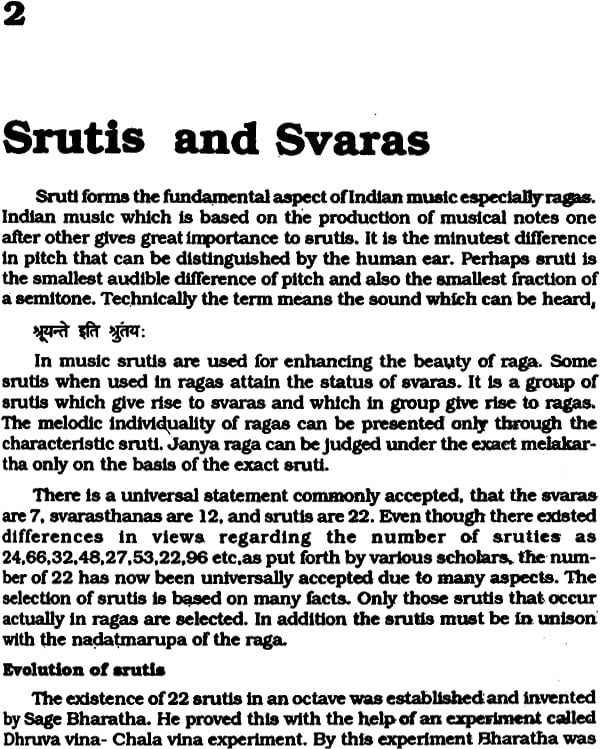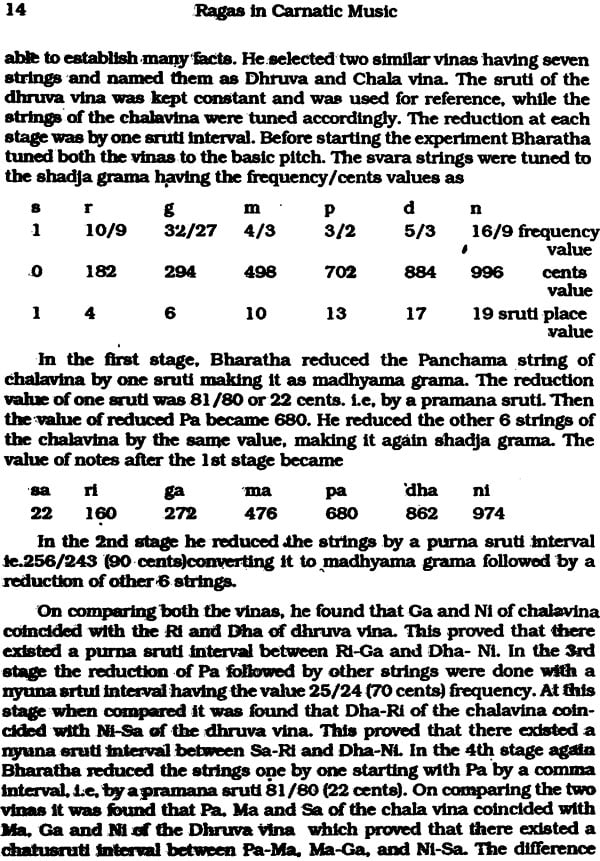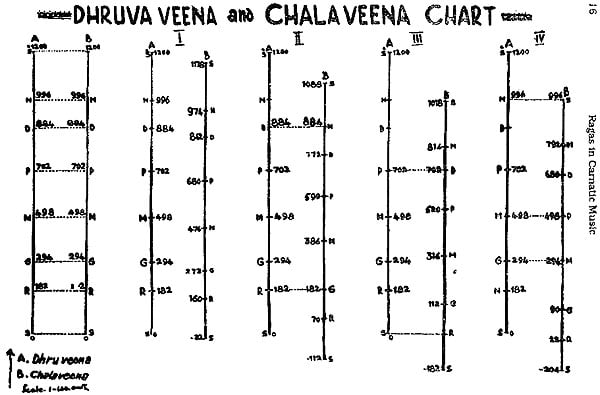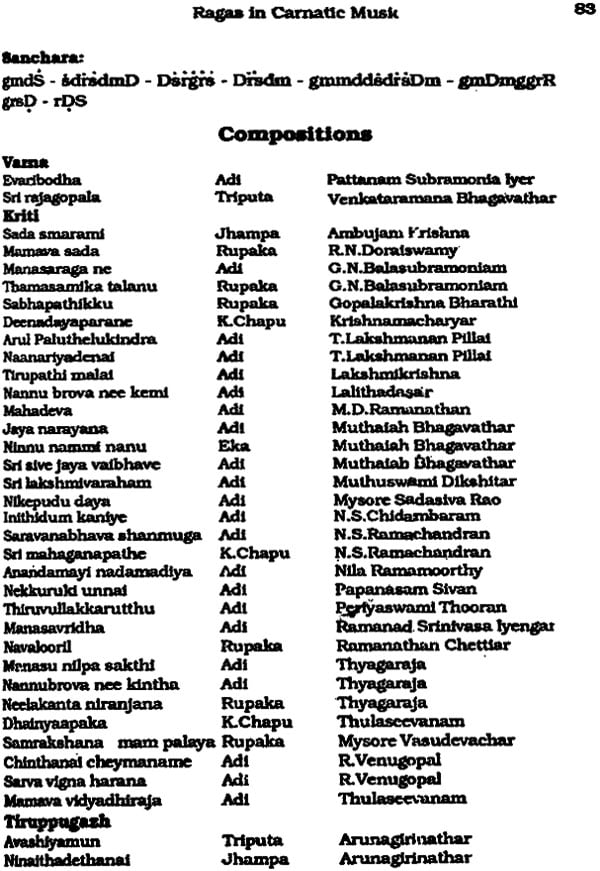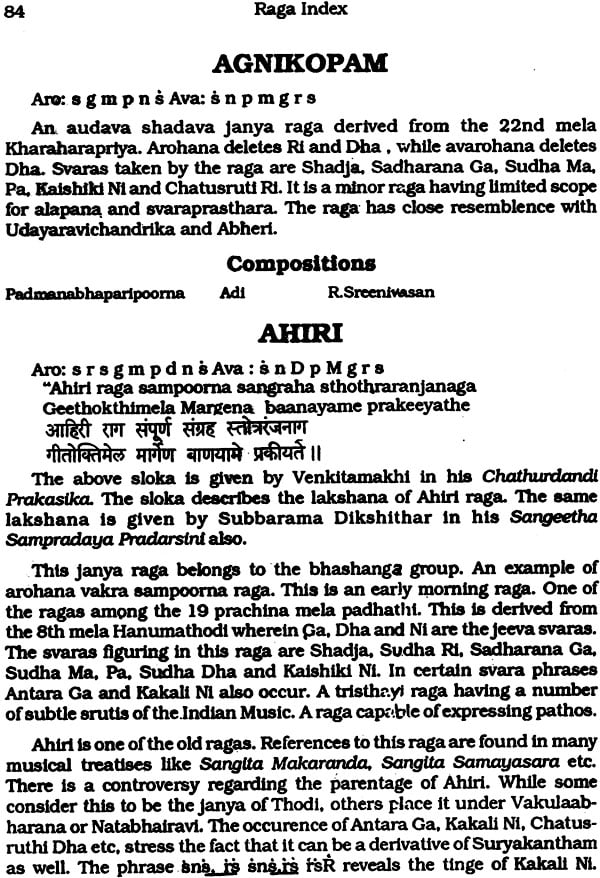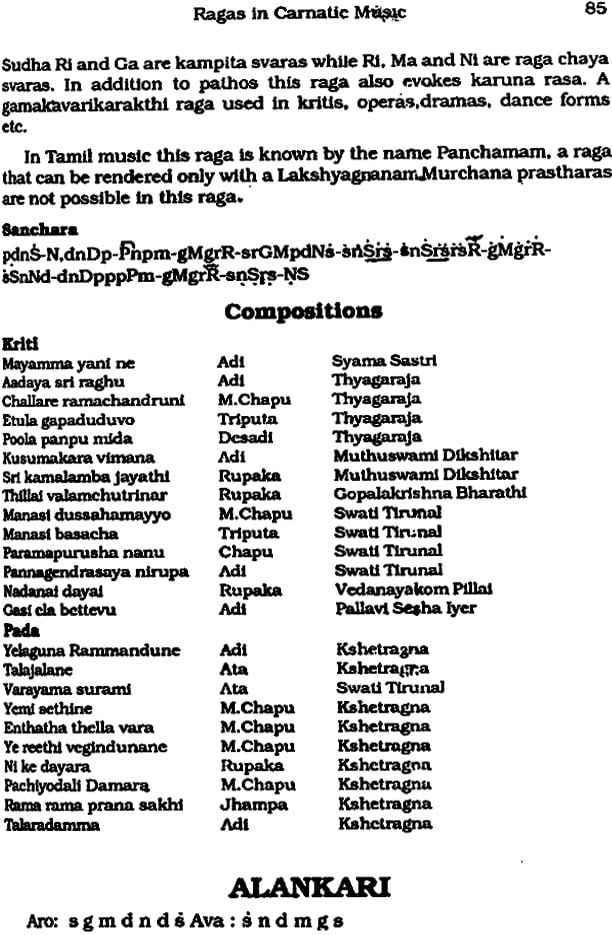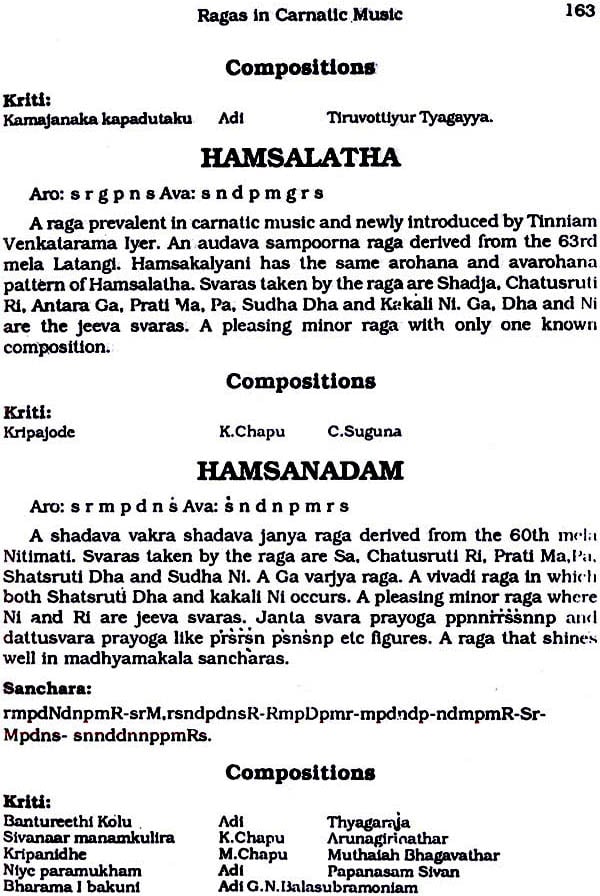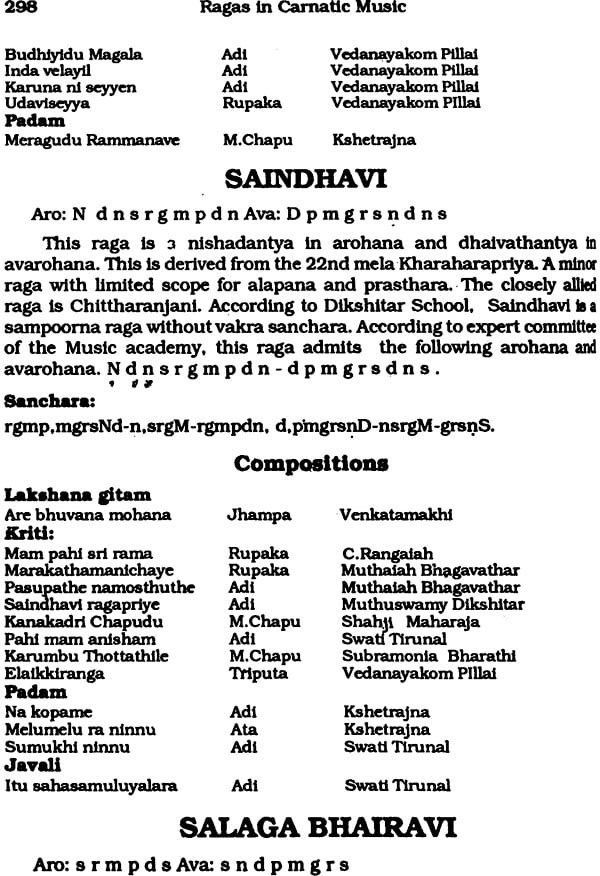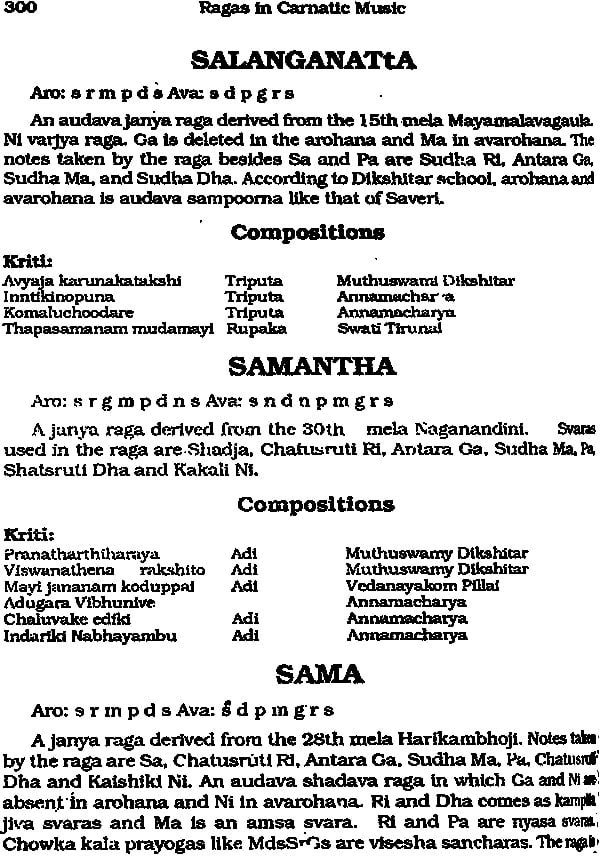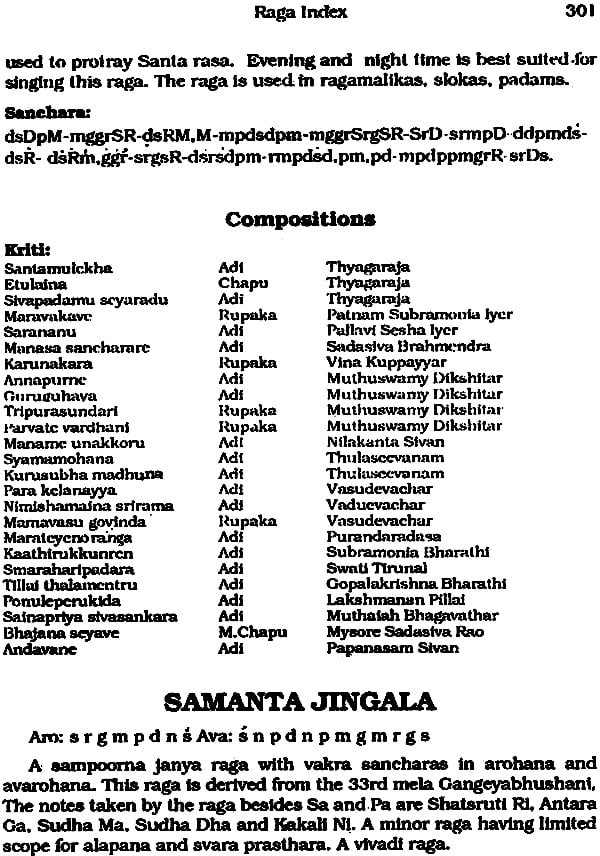
Ragas in Carnatic Music
Book Specification
| Item Code: | IDK982 |
| Author: | Dr. S. Bhagyalekshmi |
| Publisher: | CBH Publications |
| Language: | English |
| Edition: | 2019 |
| ISBN: | 9788185381121 |
| Pages: | 396 |
| Cover: | Paperback |
| Other Details | 8.6" X 5.5" |
| Weight | 360 gm |
Book Description
Back of The Book
More than 450 popular Ragas in Carnatic Music have been compiled in this volume. Each raga has been explained in detail with its swara notation, Arohana, Avarohana, Melakartha and Janya parentage, Raga lakshana and visesha sanchara for each raga. Each raga contains details about the compositions available in each raga with its tala and composer. The introductory chapters contain exhaustive material on Svaras and Srutis, Melakartha rages and their classification, janya ragas and their classification, Ragas in other systems of Music like Hindusthani, Music, Tamil Music, Kathakali Music etc. A total of more than 6000 compositions have been indexed under various ragas. An essential basic reference book for the listener, learner and every one interested in Carnatic Music.
Dr. S. Bhagyalekshmy. M.A., Ph.D. took her Doctorate on Music from University of Kerala, after having taken M.A. in Music with a first rank from same University. She has authored several books in English, Malayalam and Tamil. Karnatic Music Reader in 4 parts, Notated Editions of compositions of Tyagaraja, Muthuswamy Dikshitar, Pancharatnakritis of Tyagaraja, Maharaja Swathi Tirunal, Lakshana Grandhas in Music, Approach to Bharathanatyam; In Malayalam, Editions of Karnataka Sangeet Patamala in 6 parts, notated edition of compositions of Tyagaraja, Muthuswamy Dikshitar, Maharaja Swathi Tirunal, Purandaradasa, Syama sastri, Pancharakrities of Tyagaraja, Raga lakshanadeepika, translations of complete works of swami Tyagaraja, complete works of Maharaja Swathi Tirunal, Muthuswamy Dikshitar, in Tamil Keetana akaradi -a complete index of Carnatic Music compositions. Her audio cassettes in English Karnatic Music Learning Series in 7 parts, Pancharatnakrities of Tygaraja in 4 parts, Ragadhara - Audio Encylopaedia on Carnatic Mela and Janya Rages in 26 parts etc. She has also given video lecture on various aspects of carnatic music which are to be released shortly. All her book and cassettes have been well received. She has given several concerts all over India and is an auditioned performing artist of all India Radio, Soorya, Asianet, Doordarsan etc. She is presently Sub-Editor, State Institute for Childrens, Literature, Trivandrum.
There has been a paucity of reference books on Ragas, their origin, evolution and development and description of proper raga lakshanas. In this book, I have tried to compile in a single volume the maximum available materials on Ragas.
This book is divided into 6 chapters. Introduction, Srutis and svaras, Mela classification, Janya raga classification, Ragas in other systems of music. The last chapter enumerates detailed lakshanas of more than 450 ragas. I have also provided a detailed list of compositions against each raga with its tala and its composer..
The introductory chapter traces the origin, evolution, growth and devolopment of ragas and the different raga padhathis dating from the Vedic period to the modern period. The evolution of grama-murchanas, Jathles, scales and their lakshanas are incorporated. The three gramas with their murchanas are also included here. The second chapter entitled Srutis and Svaras contains an account of the evolution of sruti, experiments with dhruva and chala veenas, formation of twenty two Srutis, the cycles of Vth and IVth. The different Sruti nomenclature mentioned by different sangeethacharyas are included. Svaras and their varieties with quivalents in Hindustani and Western music are described. These are followed by a detailed description of gamakas and gamaka varieties.
The third chapter Mela Classification, throws light on the formation of Melas, Thaat and different Mela classifications. Evolution of different Mela padhathies are included. The fourth chapter, Janya raga classification, serves as a beacon light in getting a detailed account of Janya ragas, varjya varka varieties, upanga and bhashanga ragas, the general classification of ragas on the basic of time theory, raga-rasa aspect, similarity, allied nature etc. I hope these will be informative to students of music. In the fifth chapter on Ragas of Other Systems of Music stress is given to a general introduction to the raga systems prevalent, in Hindustani Music, Tamil Music, Kathakali Music and Western Music.
The last chapter is the content of this book. Ragalakshana of the ragas give a detailed description of major ragas. I have illustrated about 450 ragas. Almost all major composition of major and minor composers have been listed. I have tried my best to include all the known composition under each ragas. This has been difficult in the case of rare ragas because the known composition are very few.
The select Bibliography I hope will a suitable groundwork for the more detailed study of music. A glossary of technical terms, Index of composers and Index of ragas have been included to improve the usability of the book.
The work has been the outcome of the sincere editorial effort and suggestions I had received from brother M.Easwaran, for which I am deeply thankful. I am thankful to Dr. M. Hartharan and Sri M.N.Moorthy who had gone through the manuscript in its early stages and tendered valuable suggestions from a user's point of view. I also thank SriT.S.Balasubramoniam of Karnatic Music Book centre, Madras for allowing us the usage of some of the tables from South Indian Music by late Prof. P.Sambamoorthi. The book would not have come to fruition without the undaunted and moral support I received from my family members, I am also thankful to Sri.R.Radhakrishnan who had done the typing of the manuscript. I sincerely thank Smt.M.Girija, Publisher and Proprietor. CBH Publications for undertaking the publishing of the book and bringing out the book at a very short notice.
I earnestly hope this book will be found useful by students and teachers of music. I also welcome all suggestions and criticisms for the improvement of the book.

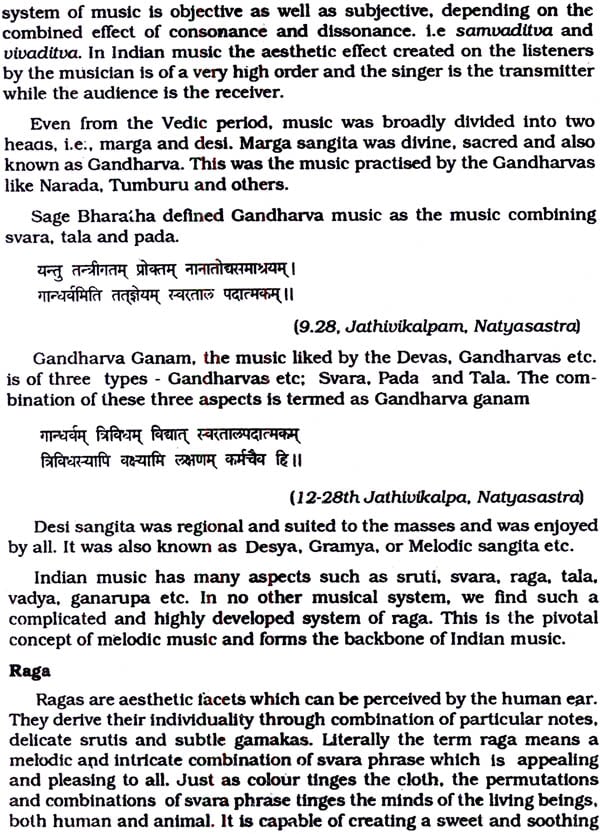

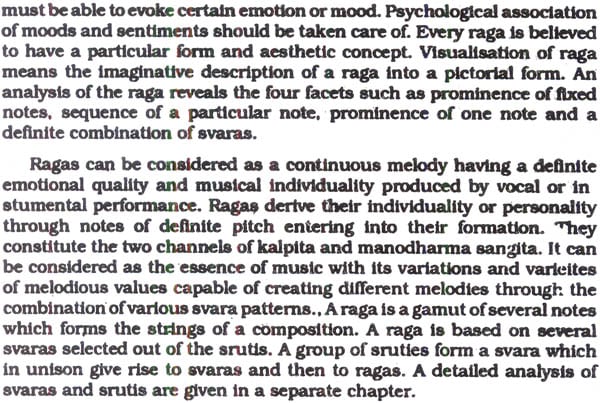
| Preface | ||
| List of Tables | ||
| Abbreviations | ||
| 1. | Introduction | 1 |
| Raga | 2 | |
| Definition Ragas | 3 | |
| Characteristics of Ragas | 3 | |
| Development of Notes and Scales | 4 | |
| Ancient Raga Classification | 5 | |
| Grama-Murchana-Jathi System | 5 | |
| Shadjagrama | 8 | |
| Madhyamagrama | 8 | |
| Gandharagrama | 9 | |
| Classification of Ragas during and Post Matanga Period | 10 | |
| Raga-Raginee Parivara System | 10 | |
| 2. | Srutis and Svaras | 13 |
| Evolution of Srutis | 13 | |
| Calculation of 22 Srutis | 15 | |
| Sruti Nomenclature | 23 | |
| Svaras | 26 | |
| Svara Scale and its Notation | 28 | |
| Vadi/ auvadi/ samvadi/ vivid svaras | 29 | |
| Garamaks | 29 | |
| 3. | Mela Classification | 33 |
| Mela ragas | 33 | |
| Evolution of Mela Padhathi | 34 | |
| 72 Melakartha Scheme | 34 | |
| Nomenclature of the 72 Melakartha Scheme | 36 | |
| Melakartha Chart | 37 | |
| Katapayadi Formula | 40 | |
| Modal Shift of Tonic | 42 | |
| Murchanakaraka Melas | 42 | |
| Evolution of New Melas | 43 | |
| Ashtottarasata Melas | 43 | |
| Heptatonic Scale of Classification | 44 | |
| 4. | Janya Raga Classification | 49 |
| Janya Raga Classification | 49 | |
| Varjya Ragas | 50 | |
| Vakra Ragas | 51 | |
| Upanga Bhashanga Classification | 53 | |
| Nishadantya, Dhaivatanya, Panchamantya Classification | 54 | |
| Ghana, naya, desya ragas | 55 | |
| Subha, chayalaga, Sankeerna Ragas | 55 | |
| Karnataka desya Ragas | 55 | |
| Kampita, Arbhakampita, Kampavihina Ragas | 55 | |
| Graha, Nayas, jiva, amsa svaras | 56 | |
| Allied Ragas | 56 | |
| Ganakala tradition | 57 | |
| Rasa bhava | 58 | |
| Ganarasa-Navarasa Classification | 60 | |
| Ragas and the appropriate rasas produced by them | 60 | |
| Influnce of ragas in Man and Nature | 61 | |
| 5. | Ragas in other Systems of Music | 65 |
| Development of ragas in Hindusthani Thaats | 65 | |
| Ragas Classification in Tamil Music | 71 | |
| Ragas and their equivalent Panns in Tamil Music | 72 | |
| Ragas in Kathakali Music | 73 | |
| Ragas in Kathakali Music and its equivalent in Karnatic Music | 76 | |
| Western Music | 76 | |
| 6. | Raga Lakshnas | 81-365 |
| Glossary of terms | 367 | |
| Select Bibliography | 371 | |
| Index of composer | 375 | |
| Raga Index | 377 |
